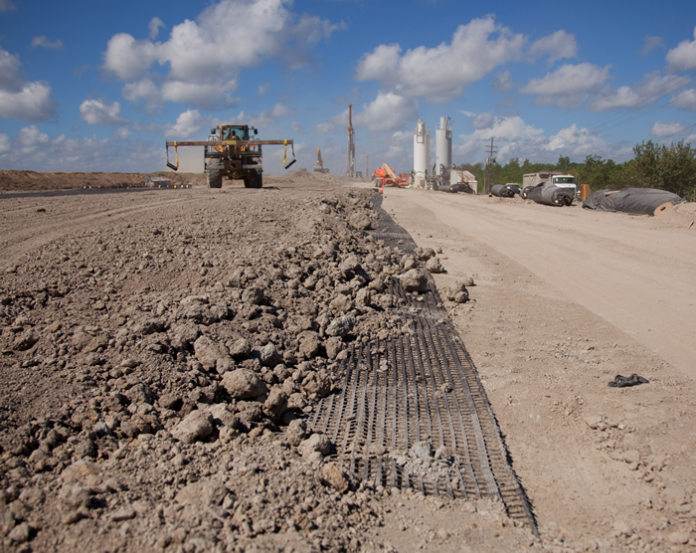
The human and infrastructure devastation inflicted by 2005’s Hurricane Katrina has led to years of levee design revisions and reconstructions in the New Orleans, Louisiana (NOLA) region. The United States Army Corps of Engineers (USACE) has been the principal driver of these projects, and geosynthetics have played new and significant roles. The 5.2-mile-long LPV 111 levee project borders the sensitive Bayou Savage National Recreation Area and epitomizes the work being executed.
As the initial project nears its 10th anniversary, we look back at how engineers have utilized both deep soil mixing pile construction and polyvinyl alcohol (PVA) reinforcement geogrids.
SEEKING HIGHER GROUND
The history of LPV 111, as with most of the levees in the region, is one of growth. In 1955, when the levee was first constructed, it was built to a height of 9 ft. In the 1970s, it was raised in three stages over four years to a height of 17 ft. Hurricane Katrina severely damaged the levee, leaving behind major scour holes. It also affected the adjacent, critical pump station (Pump Station 15). An immediate rebuild was required, and with it the Corps was able to add an additional foot of elevation. Engineers were not satisfied with that level for the long term, though.
In 2010-2011, engineers sought to raise LPV 111 to a height of 27 ft.
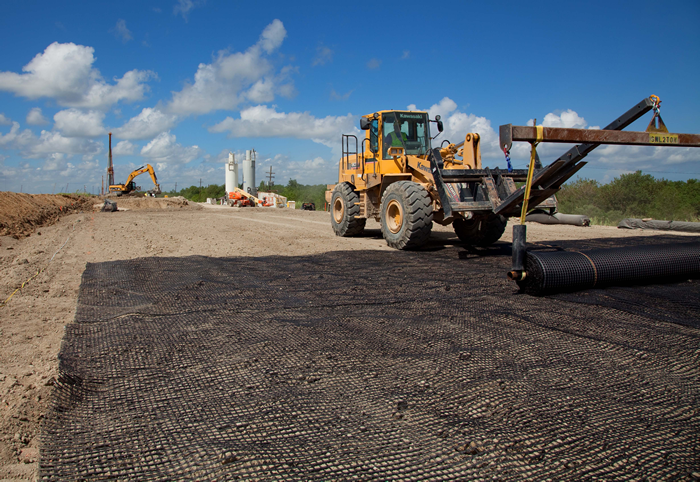
It’s no small endeavor. Surrounded by marshland, this New Orleans-area site must contend with extremely soft soils. A front-page feature story in the local Times-Picayune newspaper even commented on the difficulty of levee redesign plans with the headline: “Like Putting Bricks on Jell-O.” But building the levee to a height three times its original design is both a sign of the risk hurricanes present to this heavily populated area and what newer engineering technologies make possible.
RELATED: Harbor Maintenance Dredging and Geosynthetic Dewatering Tubes
The project presented some unique challenges too. Not only did construction need to be completed by June 2011 (approximately two years from the start of earthworks and grouting), it could not encroach upon the federally-protected wetlands of Bayou Savage and the existing levee was not allowed to be degraded.
LPV 111 – FINDING A WAY
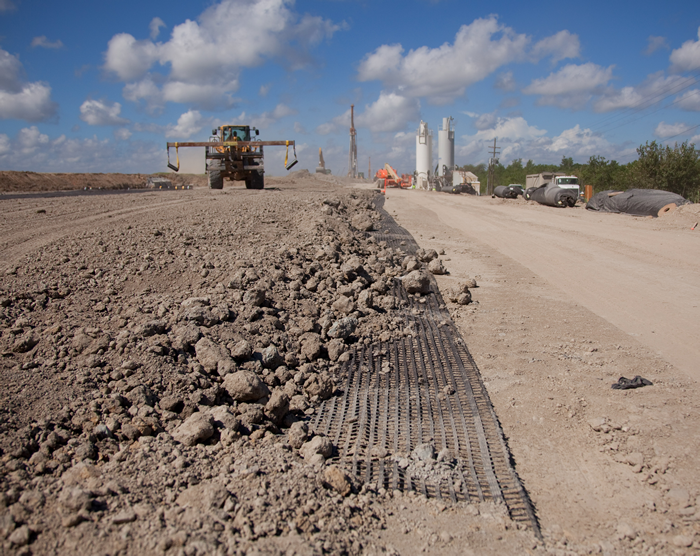
A number of common design approaches were considered but rejected. T-Walls were deemed prohibitively expensive for the location. The installation of a lightweight fill (e.g., expanded shale) was found to be too risky. There wasn’t enough time to do typical staged construction with wick drains for soil consolidation. Stability berms would necessitate encroaching upon the adjacent wetlands and stone columns were deemed impractical in these soft soil conditions.
After analyzing these and other approaches to significantly increasing the levee’s height within the constraints of the project parameters, the design team identified deep soil mixing as the best possible approach. It presented a reasonably priced option and there was local and regional experience to draw upon. Given the time constraint on the project, it was also a technique that allowed for early contractor involvement to meet the necessary window of execution.
The deep soil mixing technique involves drilling to specified depths and mixing cement into the soil to create what are, essentially, unreinforced concrete piles. Either air or water is used as the carrier mechanism with these types of deep mixing auger applications. The bearing capacity is established by drilling down to reach a firmer soil layer and mixing the soil and grout to create a firm zone.
For Levee 111, the bearing layer for the columns was at about 50 ft., but this depth did vary. Column stability was achieved through a process of overlapping mixing zones that created pairs of “soilcrete” columns that when combined formed panels or piles to support the levee. Design analysis specified that the columns should be 5.25 ft. in diameter and spaced 15.5 ft. along the longitudinal axis of the levee.
The unconfined deep mixed grout used here, as in most deep soil mixing applications in the NOLA region, cannot be lower than 100 psi. Often, 120 psi is the target.
GEOGRID SUPPORT FOR NOLA
Deep mixed piles, however, would not be enough. The stability of the structure necessitated additional reinforcement, and for time, cost and performance reasons geogrids were identified as the solution. As the geogrid layer would redistribute the load over the piles, it would improve the strength and stability of the whole levee construction.
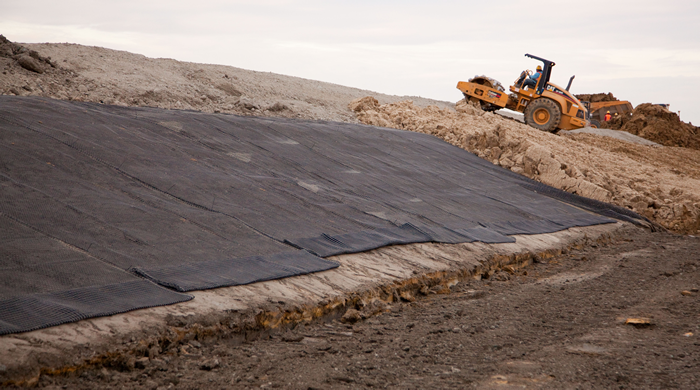
In many pile foundation constructions, geogrids can even reduce the number of piles needed, which can decrease both project time and cost while maintaining high factors of safety and long-term performance.
The three key factors used to select a geogrid for the weak soils and deep mix piles at LPV 111:
- The geogrid’s survivability in the extremely high pH environment due to the cement / soil mixture
- The geogrid’s need to possess a low long-term yield to load
- The geogrid’s need for efficient interaction with the surrounding materials.
HUESKER’s Fortrac® 400MP geogrids met and exceeded all these critical criteria. This PVA geogrid is manufactured from creep-resistant yarns, and with a wide range of standard tensile strengths available (e.g., 20 kN/m and 1200 kN/m) and the availability of custom strengths for project efficiency, it offered considered flexibility for design options. Typical reinforcement applications for this type of geogrid include railway support, steep slope stabilizations, earthen embankments over piles, bridging voids and sinkholes, and other related applications.
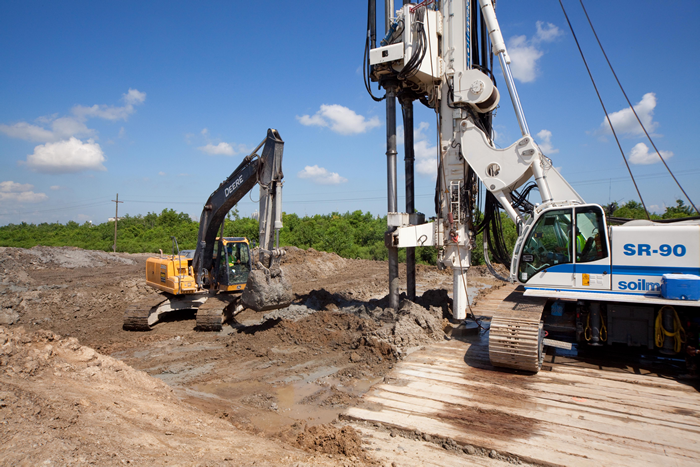
The specified geogrid was also able to tolerate an extremely broad pH range (ie, 2-13 without the need for long-term reductions of strength–well outside the range for polyester-based grids). The project’s need for pH stability performance within the soil-cement zone was satisfied.
Also in favor of this selection was the PVA reinforcement’s efficiency in terms of long-term strain vs. ultimate strength. The geogrid had a maximum 4-5% elongation during a 100-year design. For column-supported foundations where long-term deformations are undesirable, PVA reinforcements provide an excellent cost-to-performance option usually saving 20-30% in reinforcements for high-strength applications such as this. The savings increase as the required long-term strength at low strain increases.
Within the LPV 111 levee, the geogrid was designed primarily for the internal stability of the embankment over the piles. But the geogrid also helped efficiently distribute embankment loads to the piles.
An interesting aspect of the reinforcement zone is that it has been constructed with reclaimed mix. As the deep-soil mixing operation was being conducted, extra tilled material came to the surface. The use of these large drills yields about 25 to 30 percent return of a grout and soil mixture, or what is referred to as REM (Recycled Embankment Material). This REM, which has a pH of around 11-12, is then repacked atop the piles with the geogrid installed within that REM material. The ability to beneficially reuse that reclaimed soil and turn it into a good quality, high-strength fill also helps create a more efficient design.
PROJECT HIGHLIGHTS
At the time the project was put into full swing in early 2010, it was the largest deep soil mixing project in the world, with 1.7 million yd3 of mixing being performed. Drilling rigs from FUDO Construction and Trevi made it possible. During the height of production, six rigs worked two shifts for 1 year to meet the mixing demand. And it was across the resulting piles that 450,000 yd2. of Fortrac® 400MP was installed to provide the ultimate reinforcement of the structure.
Staged construction will still be utilized in some future levee work, but for time-sensitive sites such as Levee 111 a quicker solution was needed. Deep soil mixing with PVA geogrid reinforcement over the piles presented an economical, time efficient alternative that met the critical structure design strength and performance expectations.
The project was completed by May 2011, the Corps has revisited raising Levee 111 again. Public discussion on that matter began in 2019.
Levee construction throughout the NOLA region continues with many of those projects finding more cost-effective, stronger designs with the incorporation of geosynthetics. www.huesker.com
PROJECT DETAILS
Contractor: Archer Western Contractors
Design Engineering: URS Corporation
Site Owner: US Army Corps of Engineers
Reinforcement: 450,000 sq. yds. of Fortrac® 400MP
Chris Kelsey is the Editor-in-Chief and Lead Writer for Geosynthetica. He can be reached at chris@geosynthetica.net.











